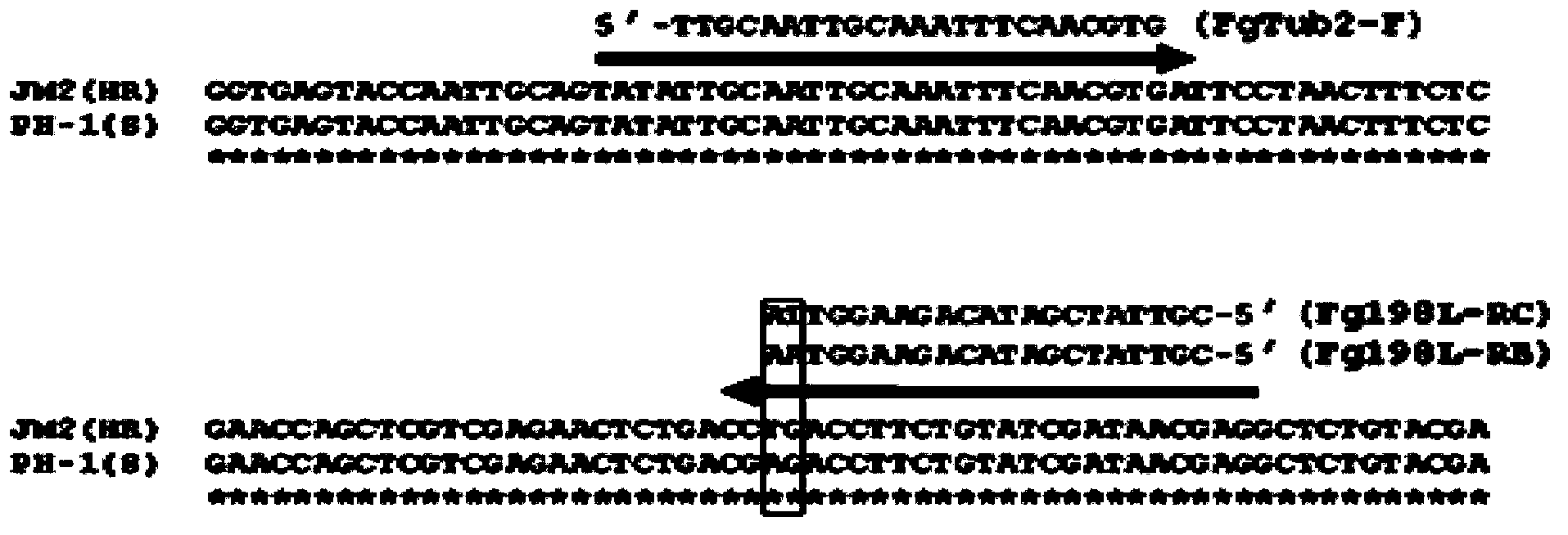Primer and method for detecting fusarium graminearum with high resistance to carbendazim
A technology of Fusarium graminearum and carbendazim, applied in the field of molecular biology, can solve the problems of lack of fast and effective molecular detection methods, inability to distinguish mutation types of resistant strains, laborious and other problems, and achieve simple and rapid extraction methods, improve Specific, easily scalable effects
- Summary
- Abstract
- Description
- Claims
- Application Information
AI Technical Summary
Problems solved by technology
Method used
Image
Examples
Embodiment 1
[0038] 1. Strain type
[0039] F. avenaceum, F. acuminatum, F. semitectum, F. subglutinans, F. culmorum 1 strain each, and 11 strains of F. graminearum. The 11 Fusarium graminearum strains included 2 carbendazim-susceptible strains (PH-1, HN9), 2 low-antibacterial strains containing the E198Q point mutation (JM51, YL10), and 2 medium-antibacterial strains containing the F167Y point mutation ( YU59, BM10), 2 medium antibacterial strains containing F200Y point mutation (BY74, QJ42), 1 medium antibacterial strain JL45 containing E198K point mutation, and 2 high antibacterial strains containing E198L point mutation (JM2, JM5).
[0040] The above-mentioned strains are all common plant pathogenic fungi, which are preserved in the Institute of Biotechnology of Zhejiang University, and can also be obtained by conventional methods of separation and purification of fungi.
[0041] 2. Primer synthesis
[0042] The study found that the high level of resistance of Fusarium graminearum t...
Embodiment 2
[0061] Example 2 Detection of Fusarium graminearum with high carbendazim resistance in ascus shells on rice piles in different regions
[0062] In April 2012, rice stumps with asthecia were collected from wheat fields in Hai'an and Jingjiang, Jiangsu, and Fanchang and Chizhou, Anhui (approximately 80 asthecias per field).
[0063] Place the ascothecia collected on rice stumps into a 1.5 mL Eppendorf tube and add 100 μl of DNA extraction buffer (1-2% polyvinylpyrrolidone (PVP), 200 mM Tris-HCl, 50 mM EDTA, 200 mM NaCl, 1% SDS, with ddH 2 O is the solvent, pH 8.0), and grind for 1 min with a pointed glass rod mounted on a commonly used electrician’s electric hand, then add 400 μl of DNA extraction buffer (DEB, DNA extraction buffer) to the centrifuge tube, vortex and mix , stand at room temperature for 10 minutes; centrifuge the above mixture at 4°C and 15,000 rpm for 5 minutes, then transfer the supernatant to another centrifuge tube, then add 750 μl of absolute ethanol, and mi...
PUM
 Login to View More
Login to View More Abstract
Description
Claims
Application Information
 Login to View More
Login to View More - R&D
- Intellectual Property
- Life Sciences
- Materials
- Tech Scout
- Unparalleled Data Quality
- Higher Quality Content
- 60% Fewer Hallucinations
Browse by: Latest US Patents, China's latest patents, Technical Efficacy Thesaurus, Application Domain, Technology Topic, Popular Technical Reports.
© 2025 PatSnap. All rights reserved.Legal|Privacy policy|Modern Slavery Act Transparency Statement|Sitemap|About US| Contact US: help@patsnap.com



